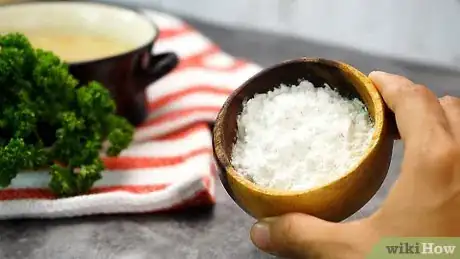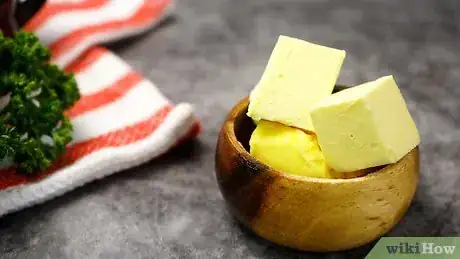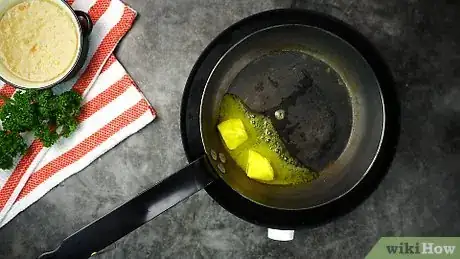This article was co-authored by wikiHow Staff. Our trained team of editors and researchers validate articles for accuracy and comprehensiveness. wikiHow's Content Management Team carefully monitors the work from our editorial staff to ensure that each article is backed by trusted research and meets our high quality standards.
The wikiHow Culinary Team also followed the article's instructions and verified that they work.
This article has been viewed 679,269 times.
Learn more...
When you think of gravy you think of a thick, delicious material. Nobody craves watery gravy. Unfortunately, some gravy recipes often turn out this way. Whether you’re having a dinner party or you’re just cooking it for yourself, there are a few ways that you can fix that liquid gravy.
Steps
Adding Cornstarch or Flour to Your Gravy
-
1Buy flour or cornstarch. You can buy both of these items at your local grocery store. Flour or cornstarch will help to thicken any sauce, and gravy is no exception. As long as you can avoid making lumps this option is the fastest way to thicken your gravy.
-
2Mix cornstarch or flour with a little water. You should put slightly more water than cornstarch or flour. There are no exact measurements here because it all depends on the amount of gravy that you have. This isn’t an exact science so you’ll have to eyeball it, but you should use approximately two tablespoons of cornstarch per cup of gravy. Make sure that you make this mix in a separate bowl. Stir thoroughly until smooth.Advertisement
-
3Add the water and flour or cornstarch mixture to the gravy. Don’t pour it in all at once, make sure you do this very gradually. Pour a little bit, stir, and then pour some more. Continue this process until all of your mixture is in the gravy. Now give the gravy another good stir to get rid of any cornstarch lumps that might still be in there. [1]
-
4Remove your mixture from the heat source when the gravy thickens. When the gravy takes on a viscous look it’s probably ready to go. You can also taste it with a spoon to see if it has reached the thickness you wanted. It’s all about your own personal taste. Just don’t let it burn. Now you are ready to serve your gravy!
Adding Gravy to a Roux
-
1Choose a fat that complements the gravy. A roux is a thickened mixture made from a fat and flour. This method is more time-consuming than the water and flour method, but the risk of lumps is minimized. Normally you should choose a fat like butter, leftover fat from the meat pan, or a suitable oil such as olive oil. The ratio is usually about half fat, half flour, although a little extra flour doesn't hurt. [2]
-
2Melt the butter or fat in a heavy saucepan. You want the saucepan to be sturdy so that you can stir in there without the pan moving all over the place. Keep the stove on about medium heat and turn it down if you smell the butter burning. This will depend on what type of stove you have.
-
3Add a similar weight of sifted flour to the melted butter or fat. Mix well, stirring constantly with a wooden spoon. Constant stirring helps to avoid making lumps. When the mixture starts to froth a little transfer it to the gravy. It should take about five minutes before the mixture froths. [3]
-
4Stir the gravy into the mixture. Make sure you stir it well, you want the mixture to fully incorporate itself into the gravy. Otherwise you risk your gravy tasting a little strange. Keep stirring until the gravy thickens – that’s how you’ll know the mixture is incorporated. If the gravy still isn’t thick enough to your liking you can always repeat the process with another roux.
Adding Arrowroot to Your Gravy
-
1Add 2 teaspoons of arrowroot for every tablespoon of flour or cornstarch that is called for in the gravy recipe. Arrowroot is a starch extracted from tropical fruit rhizomes. It's a fine powder and works really well as a last-minute gravy thickener. The arrowroot must be added to a little cold liquid and blended into a paste before being added to the hot gravy. [4]
-
2Stir the arrowroot constantly while bringing the gravy to the boil. The beauty of arrowroot is that it will stay clear, which can be important for lighter colored gravy. You don’t have stir really hard, just keep the arrowroot in motion while your gravy comes to a boil.
-
3Remove the gravy immediately once it has reached its boiling point. Any further cooking can have the reverse effect and thin the arrowroot. As soon as you see bubbles in the gravy remove the gravy completely from the hot stove plate. Don’t just turn the stove off and let the gravy sit on there – it will continue to boil! [5]
-
4Let the gravy cool and then serve. Hopefully it has reached the consistency that you were looking for. Wait about ten to fifteen before serving your gravy so that it can cool down to an appropriate temperature. You want to be able to taste the flavor after all.
Community Q&A
-
QuestionWhy do gravy granules get watery when cooled?
 Community AnswerWhen covered, the water in the gravy evaporates and collects on the covering, then drips back into the gravy. This causes the gravy to be watery.
Community AnswerWhen covered, the water in the gravy evaporates and collects on the covering, then drips back into the gravy. This causes the gravy to be watery. -
QuestionCan I thicken it with gelatin?
 Community AnswerYes, or use flour.
Community AnswerYes, or use flour. -
QuestionI made bacon gravy using equal parts bacon grease, flour, and milk. It browned beautifully, no lumps, but was granular in mouthfeel. Can you help?
 Community AnswerMake sure to try and sift the flour, it will decrease the amount of "grains." Also, add the milk all at once, but slowly, so the flour doesn't clump with the milk.
Community AnswerMake sure to try and sift the flour, it will decrease the amount of "grains." Also, add the milk all at once, but slowly, so the flour doesn't clump with the milk.
References
- ↑ http://culinaryarts.about.com/od/sauces/ht/slurry.htm
- ↑ https://www.allrecipes.com/article/how-to-make-roux/
- ↑ http://homecooking.about.com/od/specificdishe1/a/gravyroux.htm
- ↑ http://www.bonappetit.com/test-kitchen/how-to/article/gluten-free-gravy
- ↑ http://www.onegreenplanet.org/vegan-food/how-to-cook-with-arrowroot-powder/
About This Article
To thicken gravy, first mix 3-4 tablespoons (15-20 g) of flour into a little bit of water until it forms a paste. Then, just whisk the paste into the gravy a little bit at a time until the gravy is thick enough. For a gluten-free option, mix 3 tablespoons (16-24 g) of arrowroot with 3 tablespoons (45 mL) of water to form a paste, then stir the paste into the gravy. Another option is to puree some roasted vegetables, like potatoes, parsnips, or carrots, and then stir the pureed vegetables into the gravy to thicken it and add more flavor. If you want to learn how to use arrowroot to thicken your gravy, keep reading the article!

























































